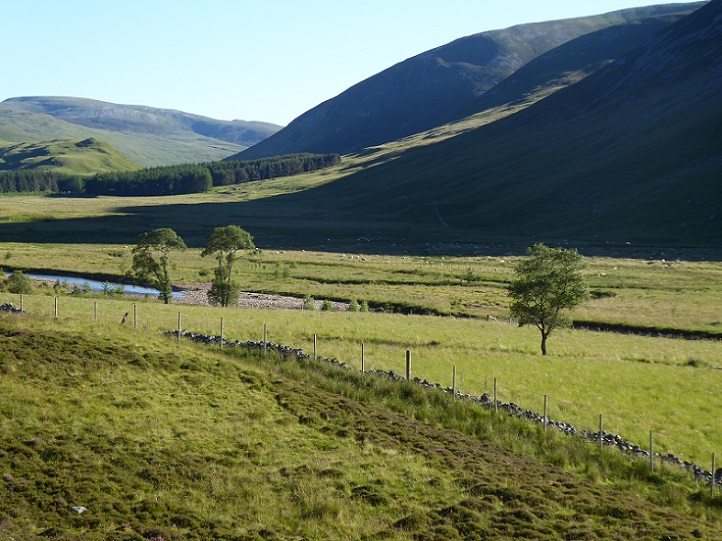
I really value the comments readers make on parkswatch posts and this week there has been an interesting debate on sheep. The first reader, rightly pointed out that it is not just deer but also sheep that prevent woodland regenerating naturally. The second comment, from Tom Colville, is worth quoting in full:
“The reason we DO need a lot of sheep , raised within enclosures [my emphasis] appears to be completely passing this generation by. This must be rectified. Each week the media report the science confirming the vast quality of plastics and fibre filaments that are now all pervasive across the ecosystem [for Ferret article on microplastic pollution of our seas this week (see here)]. Plastic filaments in the soil… seeping into ground water and river systems, in fish,and crustaceans and lining the stomachs and intestines of every living thing. Plenty remarks are to be found on this blog to condemn plastic tree protection tubes…and the many plastic byproducts that cannot be recycled, or re-purposed. Forensic science relies on microscopic plastic ”fibres from clothing that fall off every moment, to clear up crime. More fibres flow out into sewage treatment works , and compromise the processes during every wash cycle.”
“Wool can be the solution, just as it always used to be. It is of course not so durable, but it is endlessly replaceable, and it does biodegrade. Industrialists should be seeking new ways to use it , not only for textiles but incorporated back into fertilisers and soil conditioners, and also in place of foam plastics and mineral wools for building insulation. The vital thing here is to husband sheep within defined enclosures …and maybe not so much where attempts are being made to get forests to become re-established across the over drained and burnt back and barren ecological deserts which blight so many highland grouse moors”.
This, I believe, is a very strong argument to which I would add two points. The first is that the enclosures need to be in the right place and should not encroach on wild land or nature reserves where we should be allowing naturally processes to predominate – i.e there should areas where no farming or forestry takes place. The second is that within enclosures sheep can have a positive impact on nature and biodiversity. They can help, for example, maintain the flower rich meadows which are steadily being lost from the Cairngorms, so long as the grazing is carefully controlled.
By lucky timing, the sheer number of sheep I witnessed driving through Glen Shee last weekend – on either side of the five mile stretch of the A93 from below the Carn Aosda to Auchallater – prompted me to take some photos which help illustrate the issues.
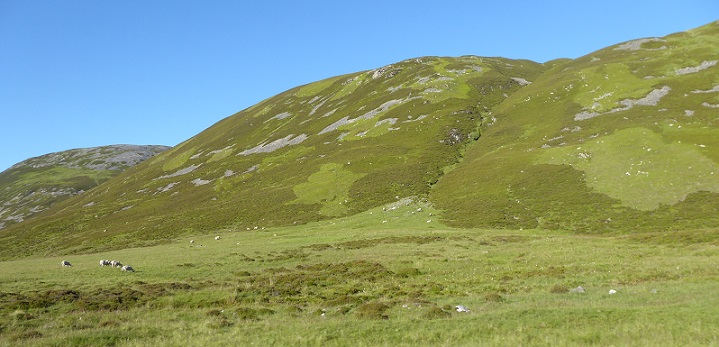
In some places they were concentrated into flocks (top photo) in others more scattered, but almost everywhere you looked there were sheep.
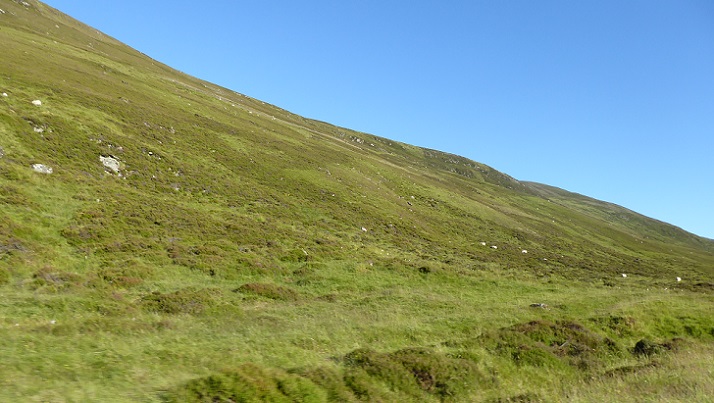
There were sheep grazing tfrom just by the road to the skyline.
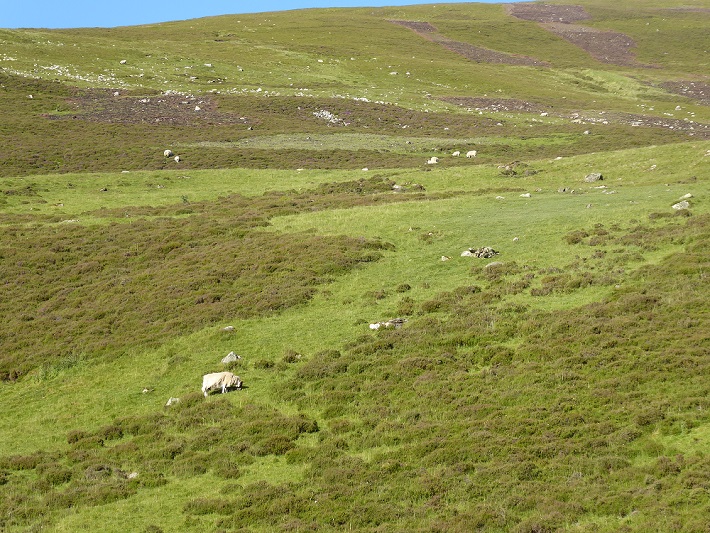 Together with the extensive muirburn, no tree has a chance. The purpose of this muirburn could be to promote grasses for sheep rather than young heather for grouse or a mixture of the two. One would hope that the Cairngorms National Park Authority (CNPA) knows the answer and understands what is driving the Invercauld estate, which owns the land, to allow the land to be used in this way.
Together with the extensive muirburn, no tree has a chance. The purpose of this muirburn could be to promote grasses for sheep rather than young heather for grouse or a mixture of the two. One would hope that the Cairngorms National Park Authority (CNPA) knows the answer and understands what is driving the Invercauld estate, which owns the land, to allow the land to be used in this way.
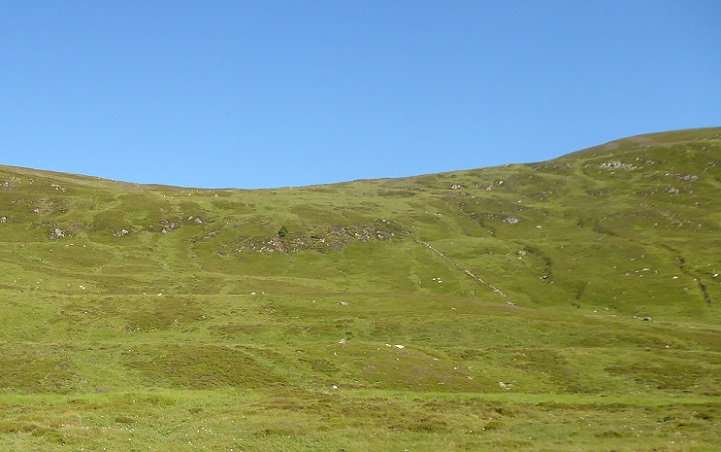
There were signs in the landscape to show that at one time enclosures were used to manage sheep in Glen Shee.
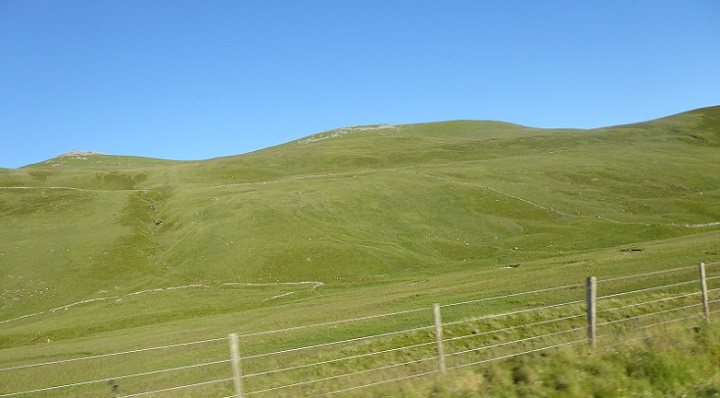
This was more obvious in Glen Beag, south of the Cairnwell, where old stone dykes criss-cross the hillside. Instead of the extensive network of stone dykes being used to manage sheep, to keep them in as well as out, fences are now mainly used to keep sheep out. An example is the stock fence in the photo, designed to prevent sheep wandering onto the A93.
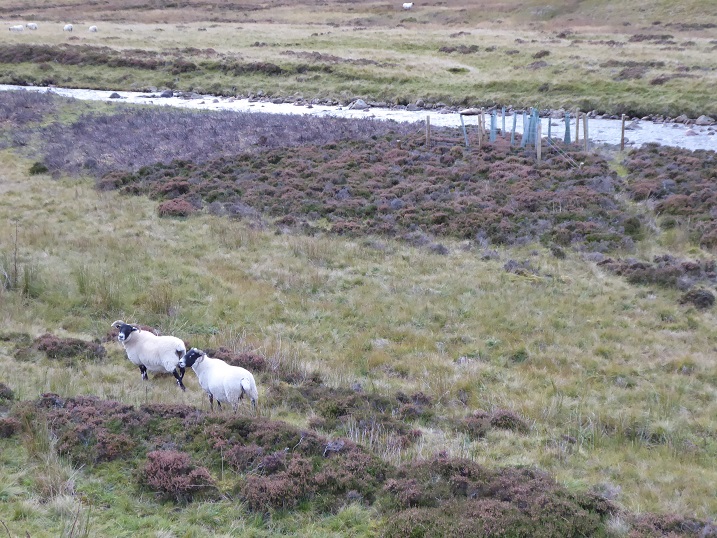
Hence too, the postage stamp planting along the Cluanie Water in Glen Shee, paid for by the public via the Pearls in Peril project (see here).
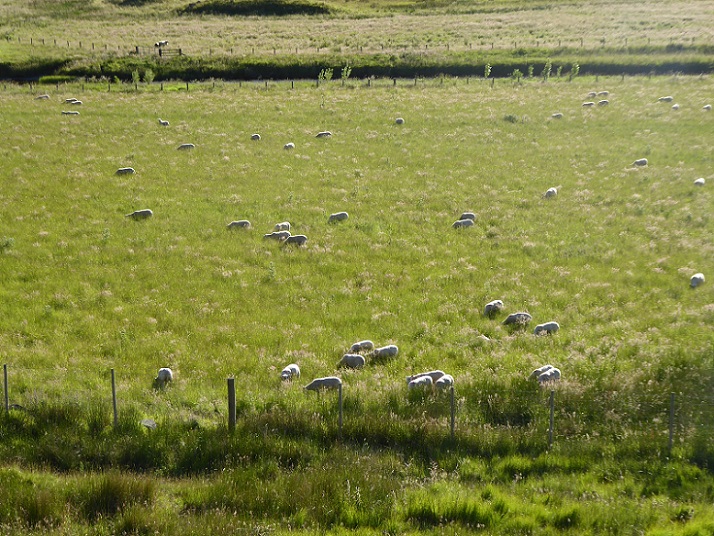
A complex network of fences exists on parts of the lower ground in Glen Shee but most of it appears designed to keep sheep and deer out of woodland planting rather than control the movement of sheep more generally. I did not think to check if the strip of land being grazed by sheep in this photo was enclosed at either end or if it serves as a corridor between plantings along the flood plain.
If enclosed, it would provide an illustration of how sheep should be managed in the National Park: kept in places with lush grazing rather than being allowed to wander all over the open hillside. The challenge would then be to determine the best balance between the number of sheep and how long they remain in each area of enclosed land, to make the most of the fodder and produce the wool we need while avoiding damage by overgrazing.
Such a grazing regime would require proactive management and more people to be employed as shepherds.
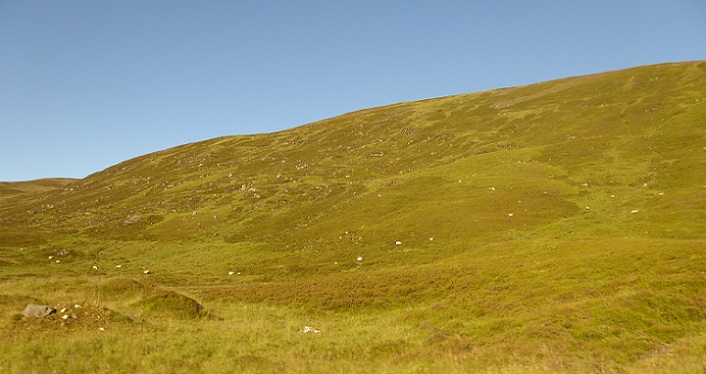
The draft National Park Partnership Plan (NPPP), approved by the CNPA board in June, includes just one reference to sheep and none to shepherds.
Policy A3 commits the CNPA to:
“Enhance the resilience of habitats, species and land use to climate change, pest and disease risks. Ensure that the integrity of designated sites is maintained, with a particular focus on:
a) ……………………….
f) Reducing red deer and other herbivore (roe deer, fallow deer, sheep and hare) numbers where needed across the National Park to enable woodlands to expand, heather loss to be reversed, peatlands to recover and wider biodiversity and landscape enhancement to take place.”
The NPPP gives no consideration to the role that sheep could play in reducing carbon emissions and pollution, saving the disappearing meadows in the Cairngorms or providing rural employment.
At least the CNPA NPPP gives sheep a mention. The word sheep does not appear once in the Loch Lomond and Trossachs National Park Authority NPPP 2018-23, despite sheep farming being far more extensive than in the Cairngorms and it being the second most important form of land-use, after forestry, in the National Park!

Where to start? Non native sheep are not part of Scotland’s ecology. Wool is not the only alternative to plastic clothing. Environmental impact of sheep raising (e.g. dipping, wool processing, imported feed etc) … People get all het up about plastic clothing but ignore the fact that the majority of micro plastics come from tyres and the majority of macro plastics in the sea come from the fishing industry. I suppose everyone (including me) has their blind spot.
Hi Helena, there is a good debate to be had! So are you arguing we should have no sheep in Scotland, because they were introduced to the British Isles with humans, or just in National Parks? I agree sheep farming as practised is not just damaging but, as you point out, can be polluting and that wool is not the only alternative to plastic. But I worry about the pair of bamboo socks I saw recently that were transported half round the world and which it was claimed were sustainable. That appears to me worse than importing feed from the lowlands – if only that happened more! One reason sheep are so destructive of uplands habitats is they have been bred to survive the Scottish winter on the open hill so the uplands are grazed 365 days a year and have not time to recover. Defenders of sheep grazing in Glen Shee, as currently practised, might argue that sheep are only there in such numbers for part of the year but that ignores the fact that there are also huge numbers of deer in the area. It seems to me we need to source more materials locally – instead of international “markets” – which is why we need to consider sheep but that could also mean growing crops like flax again.
Why has it taken so long to realise that allowing sheep to wander around the moors and hillsides, helps to destroy the environment. Cattle do a better job. They tend to avoid saplings and suchlike. Sheep keep the NATURAL trees and shrubs from making a foothold.
Planting trees especially non-native species is totally nonsensical, absolutely ludicrous.
Enough said!
As a hill shepherd, I think you will find that one of the main reasons sheep are put on the open hillside is for tick control, not only for ground nesting birds, but also for the effects that ticks can have on people I have seen the effects of lymes disease. The deer population is the majoring factor for damage to hill ground and forestry even common grazing and farmed land they can decimate a field of barley in a matter of days.
I live a stones throw from glen shee and there is a population of more than 200+ Red deer in this area alone not taking in consideration of other types of deer. I agree with you with the wool side of things it is one of the most under used products in the world and cost the producer more to take it off, but has to be done for welfare reasons. I think the parks authority need to actually sit down with the people who work the land, for example gamekeepers, farmers, shepherds and come up with an action plan, not some pencil pushing government officials and city slickers that don’t know how this land works, it’s alright driving through looking around thinking there’s too many sheep up there or too many Deer up there when you don’t understand.
The discussions also need to consider ground nesting birds.
in what sense? Because the sheep eat their eggs? (not sure if you have seen recent footage online of sheep doing this)
Cattle do a better job ? of what? earth-moving destruction of upland moorlands, and cause destruction of former rain forests? In watercourses they create bogs and morasses where they wander, their hooves break up soils so erosion and washdown occurs. On steep hillsides and banks they tread down stands of vegetation, cause land slips and crush seedlings. Their hooves pockmark soft ground damaging the subsoil . The resultant quagmires within Scotland’s highland glens do very little to permit tree seedlings or anything else a chance to take root or establish themselves for long. These rush -covered morasses are dead zones full of inedible rotting vegetation, lost to food production, too often environmentally useless.
Perhaps a moment in this discussion has arrived in which it is necessary to refocus on the intentional and clear use of the much repeated word …Enclosure? Ask whether in view of overpopulation and “food miles” today ( because humans cannot digest the poorer quality native grasses) , sheep with other ruminants can be seen as having the “battery like” potential to provide a year round source of nutrition for world populations. The temperate zone process of storing protein into a form that provides food for humans but also enhances the environment for what used to be considered ‘vermin’, (the natural predators that have always existed) – foxes , pine martins raptors,even rabbits near areas of grazed meadow. Is this not reason enough for this wider debate to be vital? (Do not even begin to consider the environmental devastation in the Sahel caused by ever growing populations – eeking out survival – surrounded dead trees and part-starved, thirsty herds of cattle sheep and goats? )
Time to understand the interdependence whole-life cycle of species, and not continue to rely on Plastics and burnt fossil fuel – released ‘unresolved’ carbon, simply because it is convenient or easier. ?
Why do modern populations depend on use of fossil energy to transport product animal and exotic from cleared forests and prairies across the globe, but talk down food that can be harvested ‘home-grown’ on Scotland’s marginal land, if only the profit motive of multinational companies and transporters was sidelined? A real appreciation of millenia of agricultural perceived wisdom within enclosed spaces should be restored instead.
Not Highland cattle in SMALL herds
Whatever the rights and wrongs of wool versus plastic, it is worth pointing out that there are major factors affecting sheep on the hills. Traditionally this was managed by hill sheep farmers but the average average age of these has been climbing steadily for a many years and they are an endangered species. Partly this is because, with the decline in the value of wool, the profitability of what was always a hard living that required a lot of skill has declined. The selling price of sheep pelts at sheering hardly covers the cost of doing it and a major reason for sheering is protecting the health of the sheep. Sheep of course were not left grazing on the hill all year but were taken into the “in bye land” within the main dyke over winter and early spring and muirburn provided you more nourishing feed in the regrowth. As far as I know in a place like Glen Clova, the last sheep farmers have gone. One of the reasons for the disappearance of hill sheep farmers is that estates with grouse moors have been pressuring sheep farmers to give up their sheep so that they can use them as “tick mops”, as many will know, often putting them under a lot of pressure to do so. One farmer I know was thus pressured strongly even while very ill. He finally accepted and vacated his substantial farm house, which was flattened within days of him and his wife vacating it. When the estates taking over the sheep, the question arises who is looking after them? “Contract Shepherds” the say. Where from? Good shepherds have been like hens teeth for years. As far back as 1980 I can recall being called onto a farm with sheep dying everywhere because the estate gave the job to a cattle man as three adverts for the job failed to attract on application. All that apart, the changes in landuse that are going on in the hills are major. A recent report I read on changes in agriculture made it clear. Considering the whole of Angus for example, there is lower fertile Angus and the Angus Glens. Lower Angus is intensifying it said but the “Angus Glens are coming out of agriculture!! That’s a lot of hills
I lived in Glenisla for five years and was familiar with the farming community both in Glen Isla and Glen Clova. In the 50’s (I am 75 years of age), there were many farmers in both glens.
In the letter re. a farmer being ‘forced” to leave the glen, this is typical of what’s going on unfortunately.
The landed gentry, say from Cortachy Castle, ie the Earl of Strathmore, and his ilk, own thousands of acres and the Grouse shoot is very much still popular. My Greatgrandfather was called William Carnegie and was 100 years ago the Head Gamekeeper to the estate. In these days it was a huge industry.
Nowadays, the ‘shoots’ often consists of killing pheasants which are reared by the 1000 and released into the wild. They are so tame that you could walk up to them and they won’t fly off. Yet, this is called a SPORT!!!!
It’s long over due that this is stopped AND Grouse shooting which causes a lot of damage to the habitat in the glens, particularly the raptors, should be completely banned!